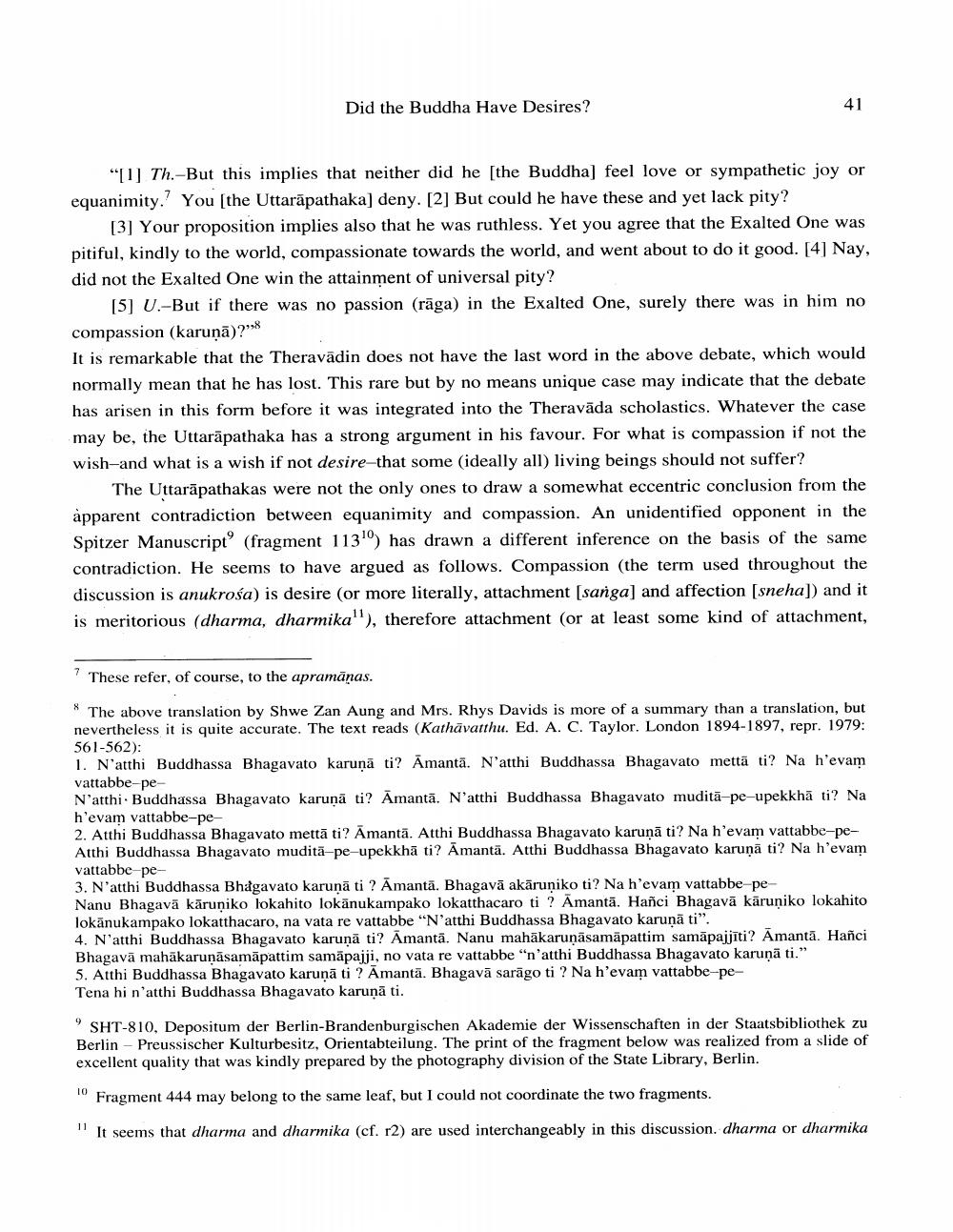________________
Did the Buddha Have Desires?
“[1] Th.-But this implies that neither did he [the Buddha] feel love or sympathetic joy or equanimity. You [the Uttarāpathaka) deny. [2] But could he have these and yet lack pity?
[3] Your proposition implies also that he was ruthless. Yet you agree that the Exalted One was pitiful, kindly to the world, compassionate towards the world, and went about to do it good. [4] Nay, did not the Exalted One win the attainment of universal pity?
[5] U.-But if there was no passion (rāga) in the Exalted One, surely there was in him no compassion (karuņā)?"** It is remarkable that the Theravādin does not have the last word in the above debate, which would normally mean that he has lost. This rare but by no means unique case may indicate that the debate has arisen in this form before it was integrated into the Theravāda scholastics. Whatever the case may be, the Uttarāpathaka has a strong argument in his favour. For what is compassion if not the wish-and what is a wish if not desire-that some ideally all) living beings should not suffer?
The Uttarāpathakas were not the only ones to draw a somewhat eccentric conclusion from the apparent contradiction between equanimity and compassion. An unidentified opponent in the Spitzer Manuscripto (fragment 1139) has drawn a different inference on the basis of the same contradiction. He seems to have argued as follows. Compassion (the term used throughout the discussion is anukrośa) is desire (or more literally, attachment (sanga] and affection (sneha]) and it is meritorious (dharma, dharmika"), therefore attachment (or at least some kind of attachment,
These refer, of course, to the apramānas.
The above translation by Shwe Zan Aung and Mrs. Rhys Davids is more of a summary than a translation, but nevertheless it is quite accurate. The text reads (Kathāvatthu. Ed. A. C. Taylor. London 1894-1897, repr. 1979: 561-562): 1. N'atthi Buddhassa Bhagavato karunā ti? Āmantā. N'atthi Buddhassa Bhagavato mettā ti? Na h'evam vattabbe-pe N'atthi. Buddhassa Bhagavato karunā ti? Amantā. N'atthi Buddhassa Bhagavato muditā-pe-upekkhā ti? Na h'evam vattabbe-pe2. Atthi Buddhassa Bhagavato mettā ti? Amantā. Atthi Buddhassa Bhagavato karunā ti? Na h'evam vattabbe-peAtthi Buddhassa Bhagavato muditā-pe-upekkhā ti? Amantā. Atthi Buddhassa Bhagavato karunā ti? Na h'evam vattabbe-pe3. N'atthi Buddhassa Bhagavato karunā ti? Āmantä. Bhagavā akäruņiko ti? Na h'evam vattabbe-pe Nanu Bhagavā kāruņiko lokahito lokānukampako lokatthacaro ti ? Amantā. Hañci Bhagavā kāruņiko lokahito lokānukampako lokatthacaro, na vata re vattabbe "N'atthi Buddhassa Bhagavato karunā ti". 4. N'atthi Buddhassa Bhagavato karuņā ti? Amantā. Nanu mahākarunāsamāpattim samāpajjīti? Āmantā. Hañci | Bhagavã mahakarunasamāpatim samāpajji, no vata re vattabbe “n'atthi Buddhassa Bhagavato karuna ti.” 5. Atthi Buddhassa Bhagavato karuņā ti? Amantā. Bhagavā sarāgo ti? Na h'evam vattabbe-peTena hi n'atthi Buddhassa Bhagavato karunā ti.
SHT-810, Depositum der Berlin-Brandenburgischen Akademie der Wissenschaften in der Staatsbibliothek zu Berlin - Preussischer Kulturbesitz, Orientabteilung. The print of the fragment below was realized from a slide of excellent quality that was kindly prepared by the photography division of the State Library, Berlin.
10 Fragment 444 may belong to the same leaf, but I could not coordinate the two fragments.
" It seems that dharma and dharmika (cf. r2) are used interchangeably in this discussion. dharma or dharmika




